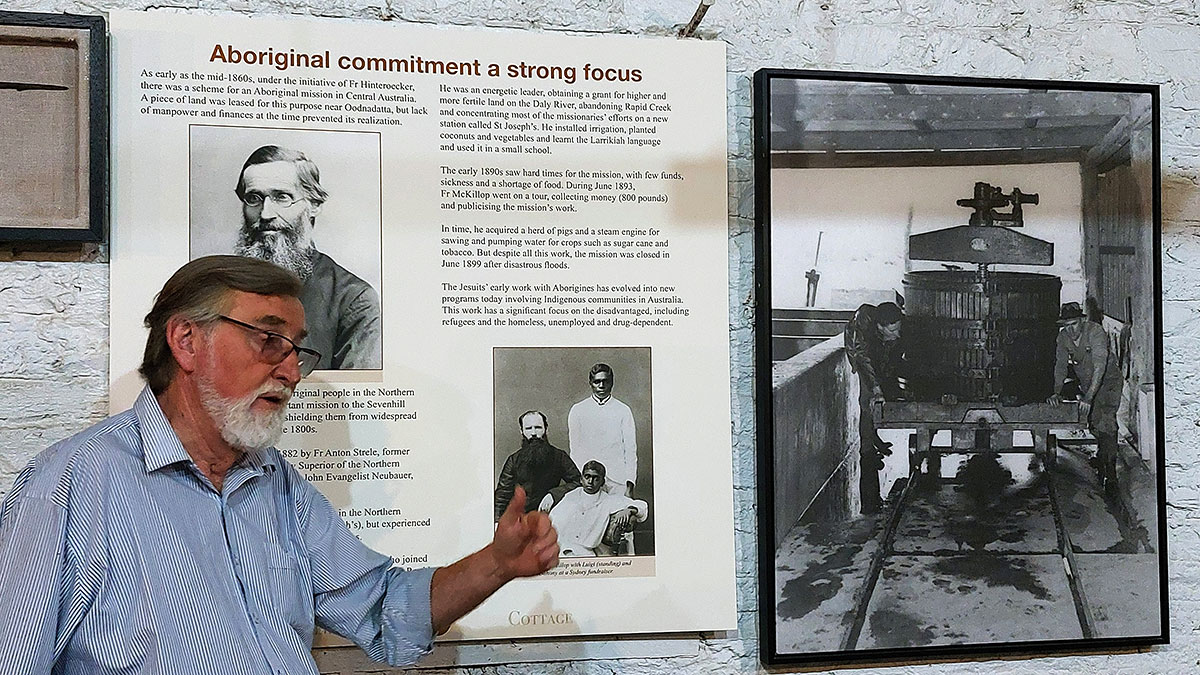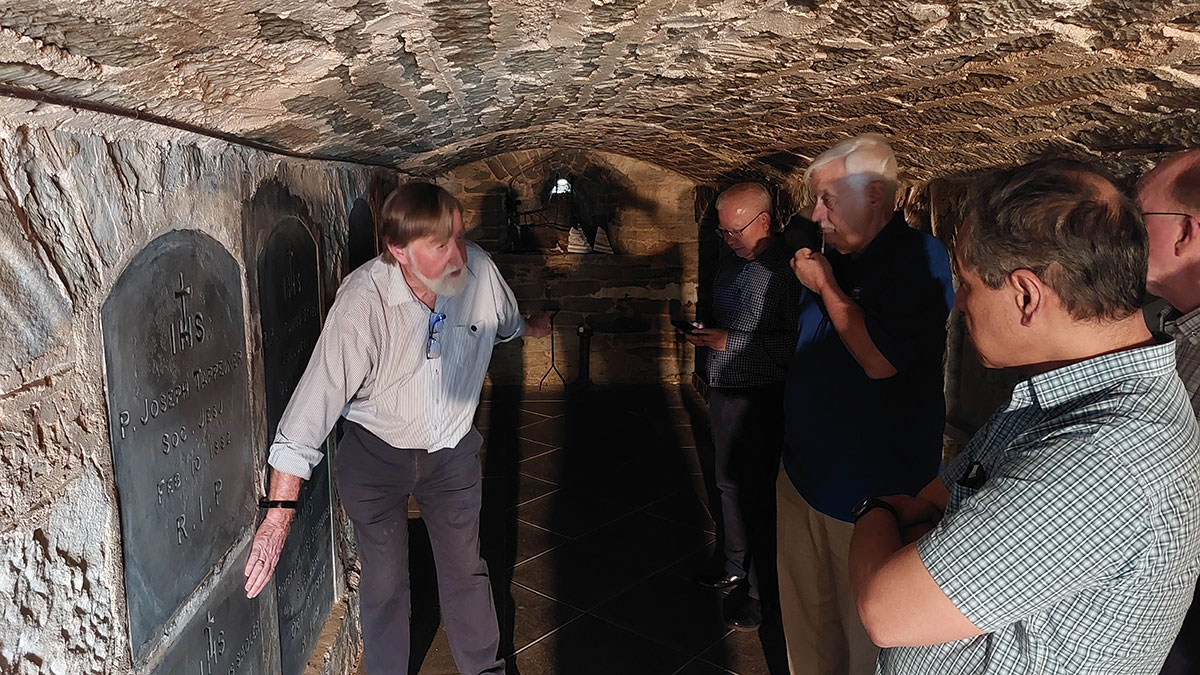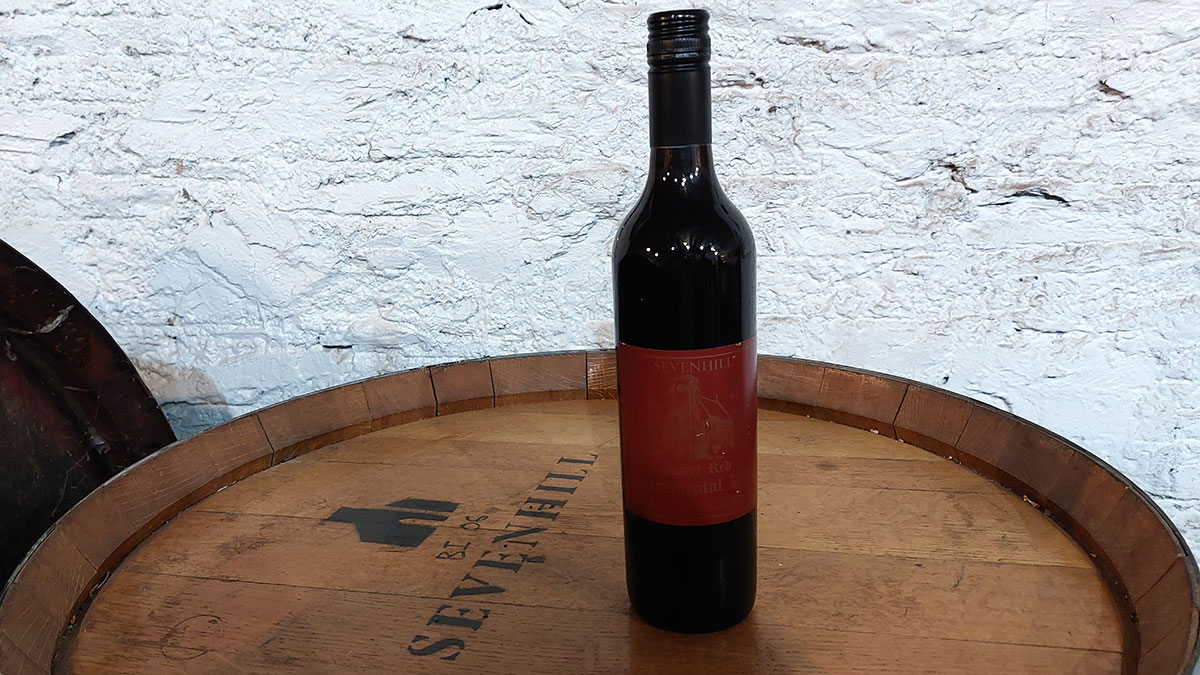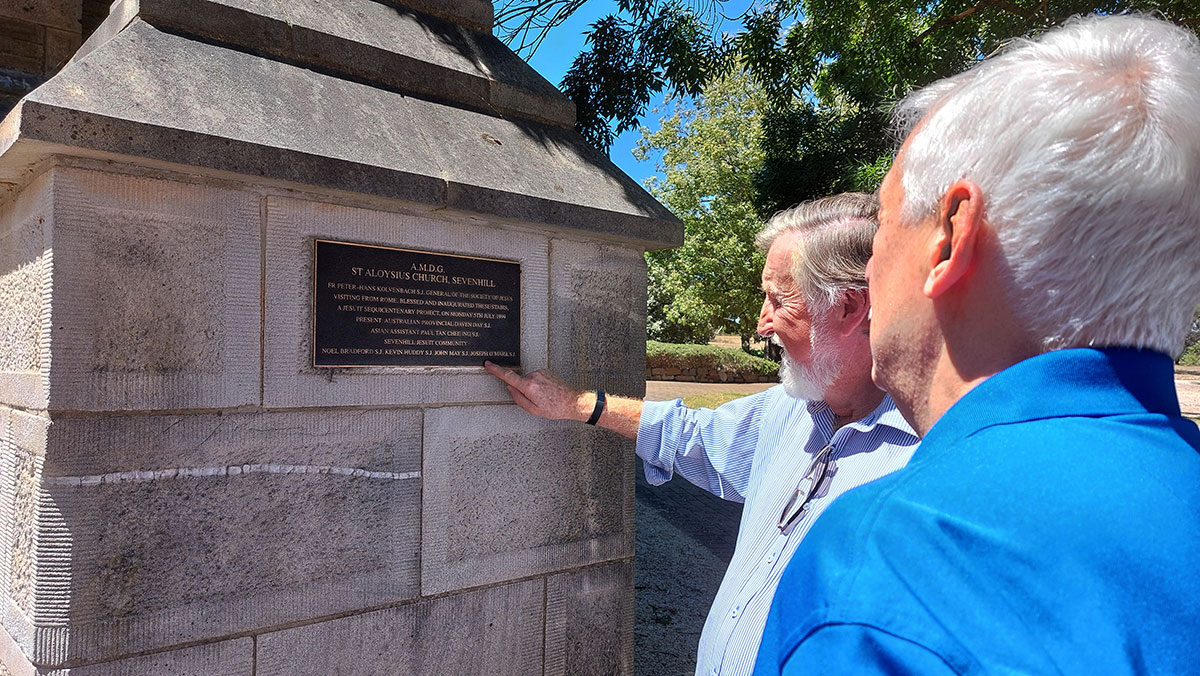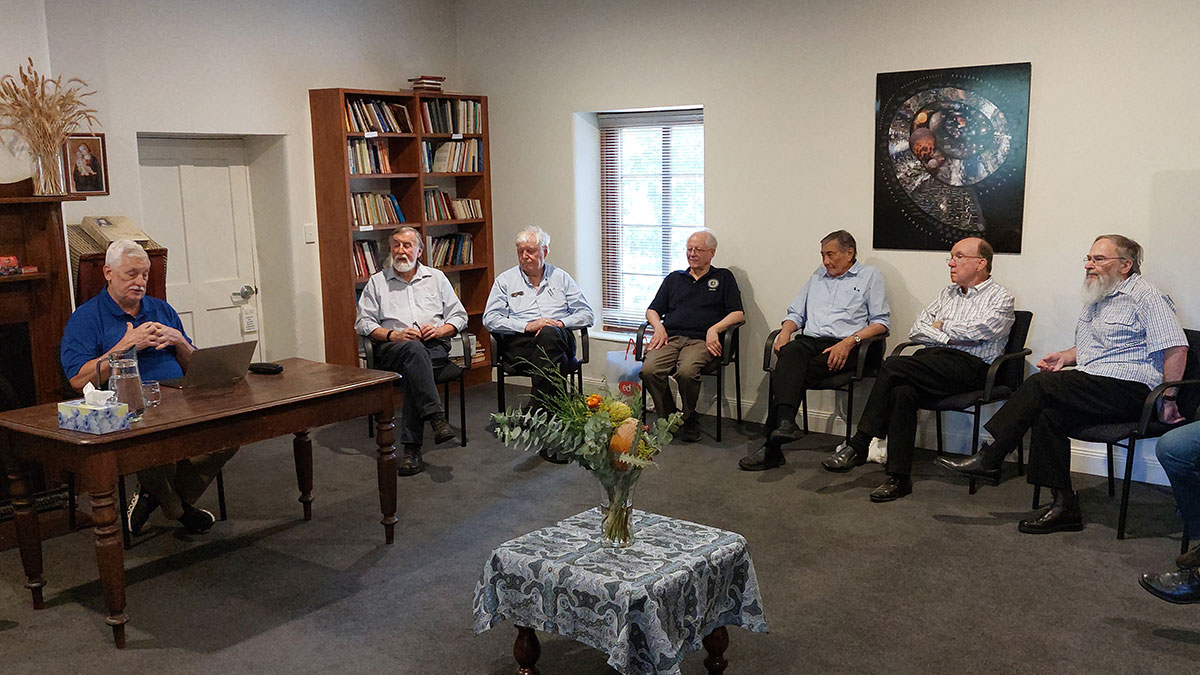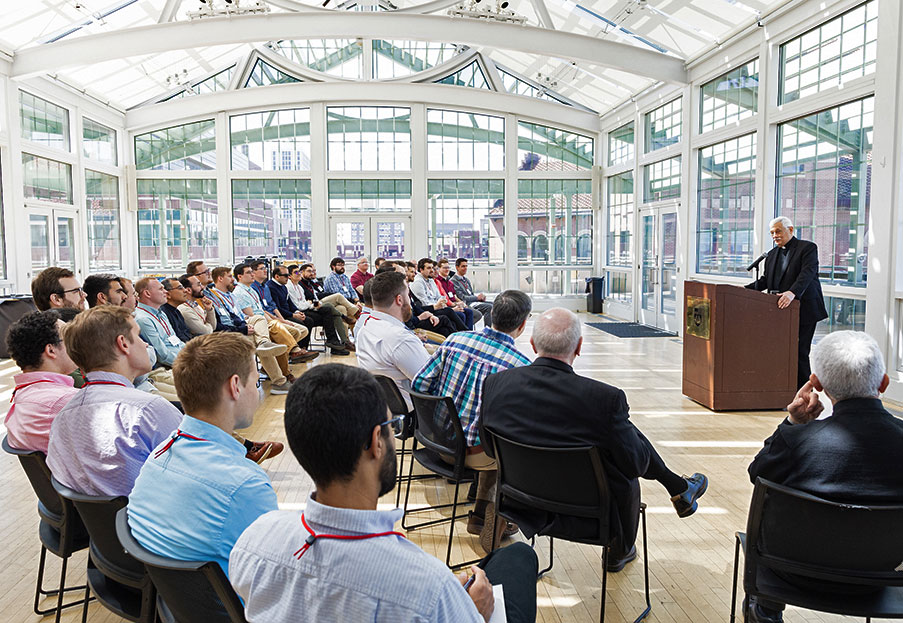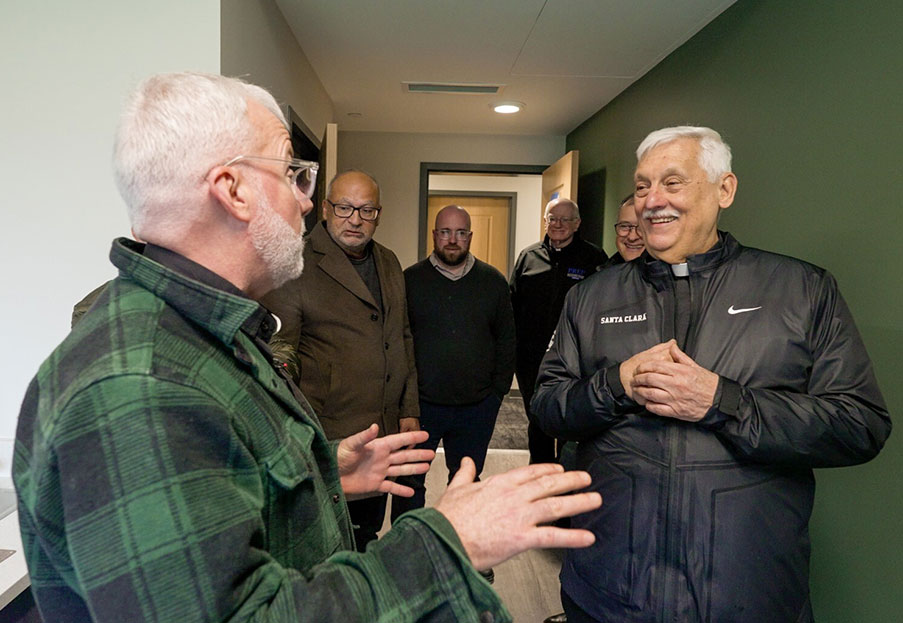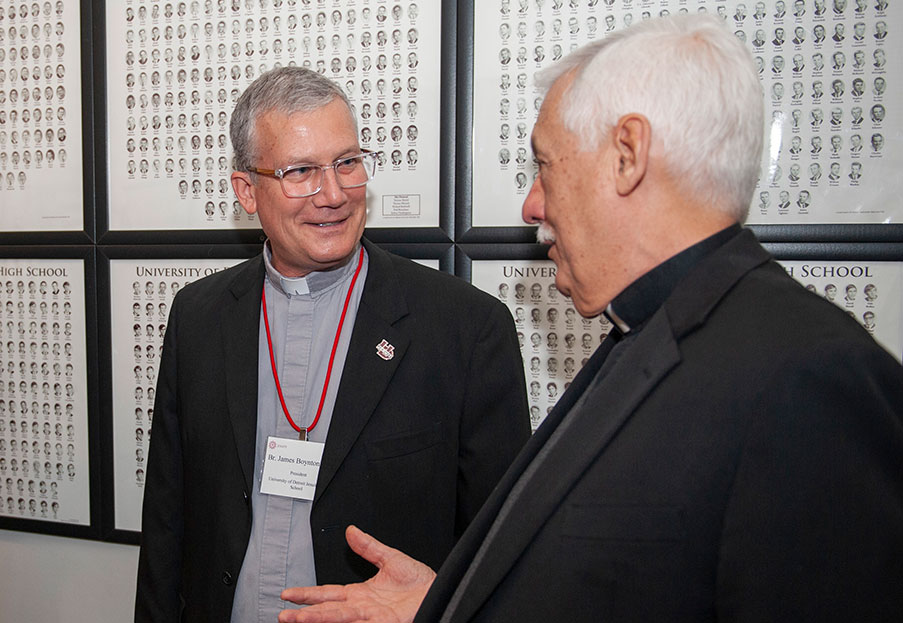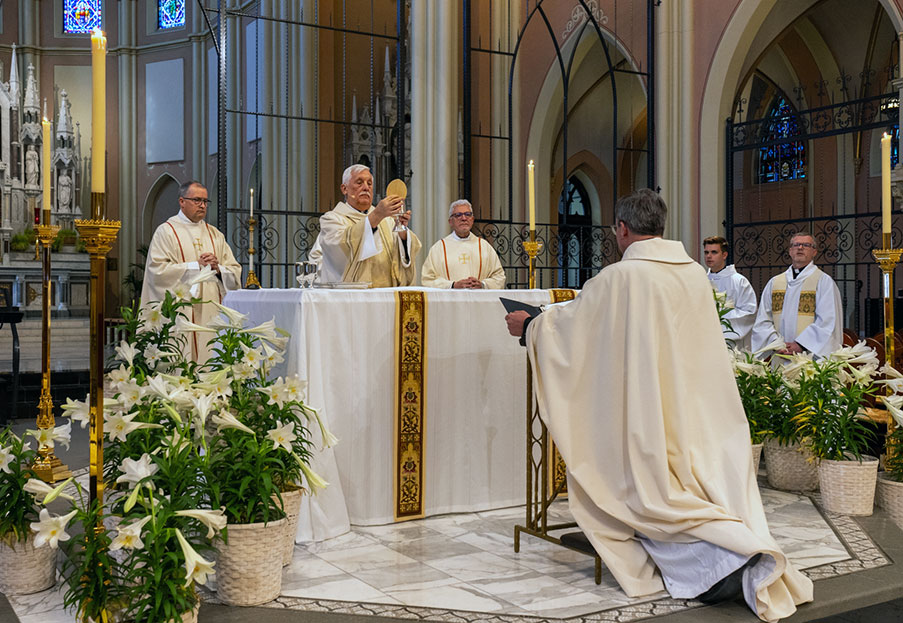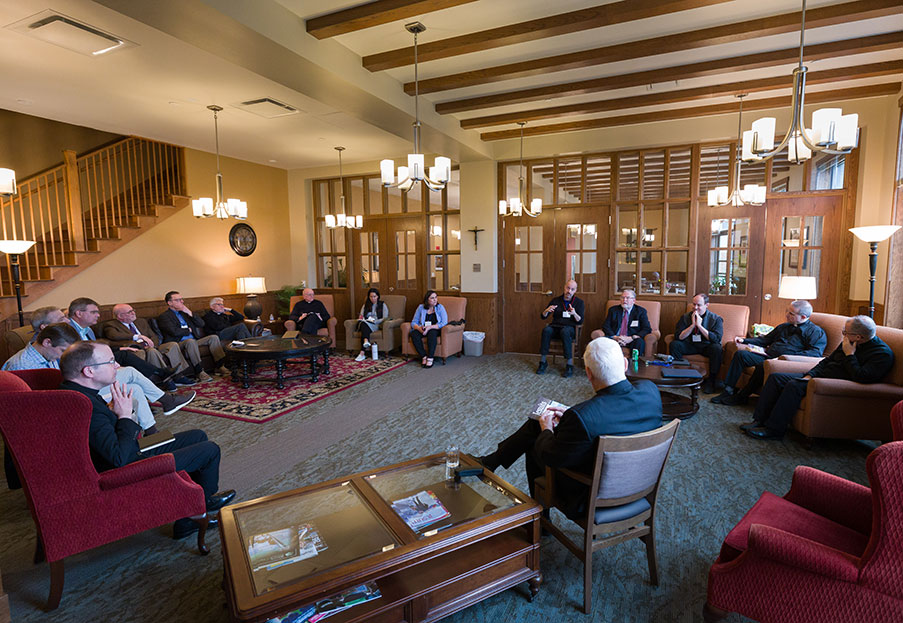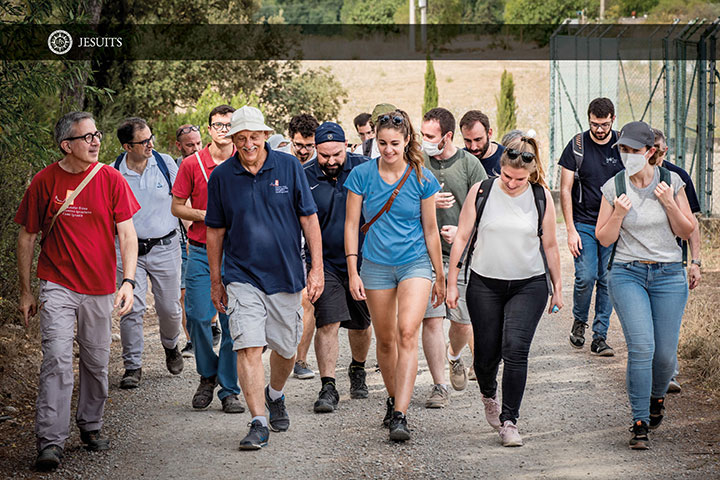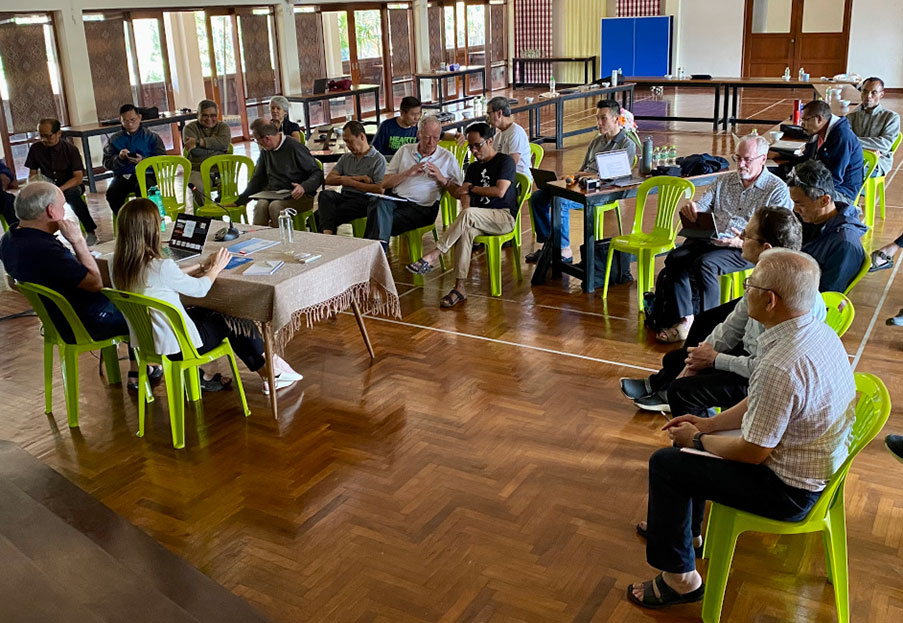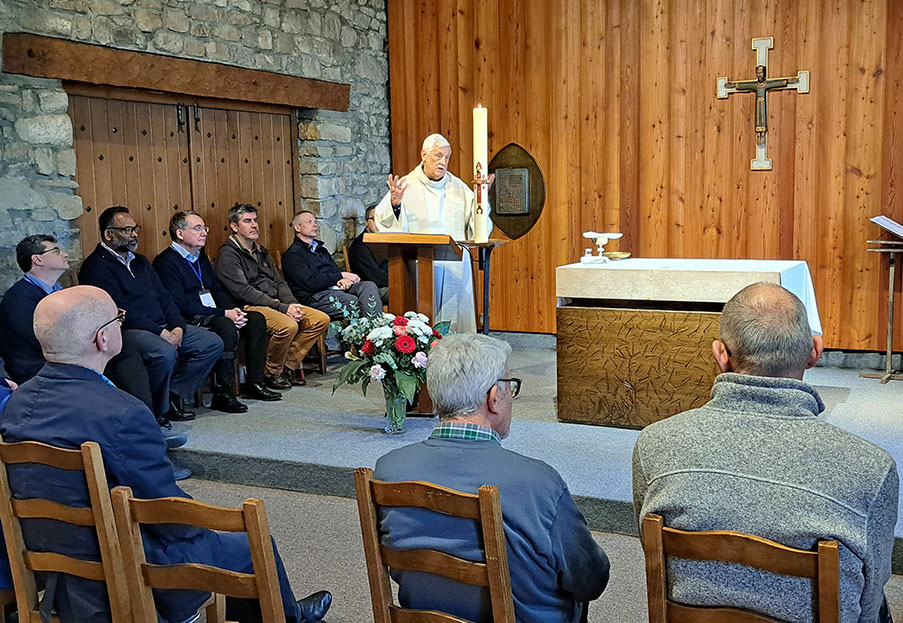A Jesuit vineyard
Fr General visits Sevenhill
Fr Arturo Sosa continues his discovery of the Australian Province. Another flight of less than two hours took him from Melbourne to Adelaide. Add some two hours by road and you’re in Sevenhill, the cradle of the Jesuit presence in this vast country. If the name rings a bell, it’s perhaps because of the reputation of its vineyard... a Jesuit work! Of course, Father General visited the winery and tasted its wine. But above all he became aware of the scale of the Jesuits’ project in this region over the last 175 years. Initially, it was to provide pastoral care for immigrants from Prussia driven out by persecution. This is where the settlement and expansion of the European presence in the colony began.
The current superior, Fr Brendan Kelly, has no hesitation in saying that what DNA is to the human body, Sevenhill is to the Society of Jesus in Australia. That’s where it all began. This is where we still find today the soul of the integral and integrated mission of the Society, which was able to create a synergy between parish ministry, the promotion of the Spiritual Exercises and the management of a vineyard. It all fits together: one part cannot function without the other two. It’s a world of collaboration and mutual support that benefits the whole Province. In concrete terms, we’re talking about two parishes with eight churches, a spiritual centre that can’t keep up with the demand for Ignatian retreats, and a vineyard that specialises in the production of altar wine but that also produces renowned table wines.
But still, a vineyard! We challenged Brendan Kelly to convince us...
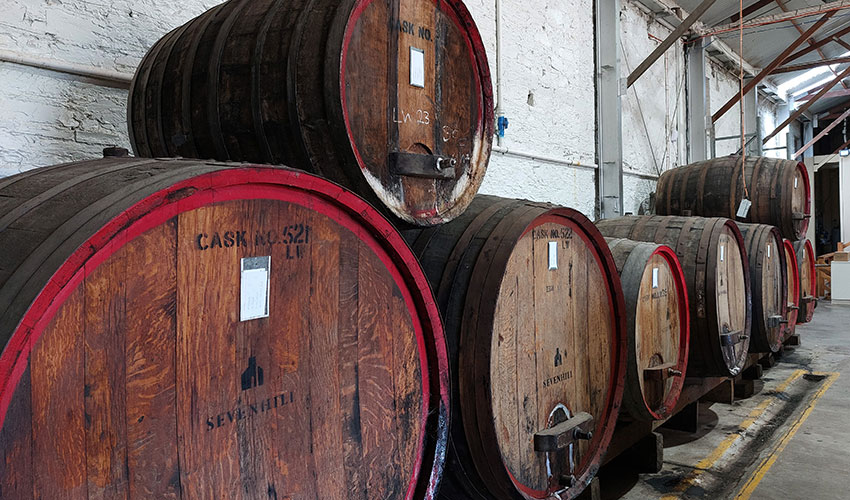
What is the significance for the Society of Jesus in Australia, to own and manage a vineyard? Could it be seen as a business operation not much in line with religious poverty?
The production and sale of altar wine to parishes and religious congregations within Australia and overseas to celebrate the Eucharist has always been and remains the primary raison d’être for the Jesuit Sevenhill winery. The production of some table wines is an entrée to the name and the mission of the Society of Jesus, to those who otherwise might not come in contact with us. Each year, between 35,000 and 50,000 people visit the winery as well as our Church and shrines on our property. All financial surplus made by the winery is used to assist in promoting and sustaining valued and especially poorer ministries of the Jesuit Australian Province.
How does this work, Sevenhill Cellars, fit within the Apostolic Plan of the Australian Province, or how could it be related to the Universal Apostolic Preferences of the Society of Jesus?
Sevenhill is the main centre for the delivery of the full Spiritual Exercises, which are given three times annually, and includes the very popular Australian Jesuit tertianship retreat. The setting for our main retreat house, Sevenhill College, is among the vineyards. Over the years, the winery has maintained the conducive and beautiful setting for our retreats, assisted with maintenance of grounds and buildings, and provided altar and table wine for our retreatants. The winery has reached out and supported various works of the Province, notably Jesuit Mission, our social ministries, and our schools by way of financial contribution and promotion with fund-raising activities.
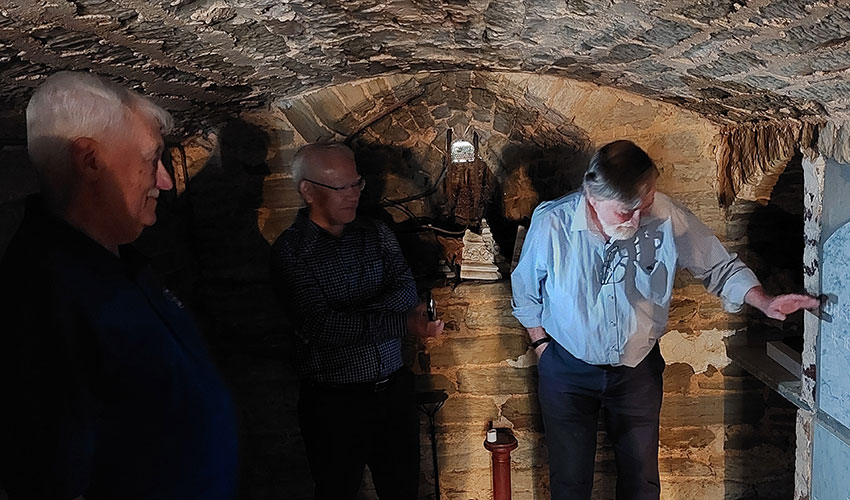
Many young families visit Sevenhill and make use of the picnic grounds that the winery provides. The winery, with the retreat house, supports the initiatives taken with the young in our parishes. For example, Sevenhill hosted the recent Archdiocesan Regional Assembly, which considered topics of ministry with youth and young families, faith formation, leadership and outreach, welcome and inclusion. Also, with some 286 hectares of rural property to tend, the winery very practically leads the way in our Province to give Laudato Si’ Ecological Retreats, retreat walks are conducted from Sevenhill, and the winery contributes to the maintenance and care of the world heritage white beauty spider-orchid!
What would you like Father General to remember from his visit to Sevenhill Cellars?
We would hope he will remember the unfolding history of Sevenhill as an inspiring place of Jesuit mission with its unique configuration of a synergy of ministries: parish, retreat centre, and winery. What we would like the General to take away with him from his visit to Sevenhill is also a sense of the pioneering and enterprising spirit that informs these works. In its configuration of ministries, Sevenhill is known in both church and non-church circles: it is meaningful in a very secularized country. We would like the General to know that the service of the Gospel continues in remote places, even ‘on the other side of the earth’. We would also hope that Father General sees Sevenhill as making a valuable contribution in the Oceanic-Pacific area in the ongoing celebration of the Eucharist to worshipping communities, being a major producer of altar wine.
View the Photo-essay about Sevenhill prepared by David McMahon, the Communication Manager of the Australian Province. It is titled Hallowed Turf. It highlights, among other things, the relationships nurtured between the Jesuits of Australia and the Aboriginal peoples.
From dawn to dusk:
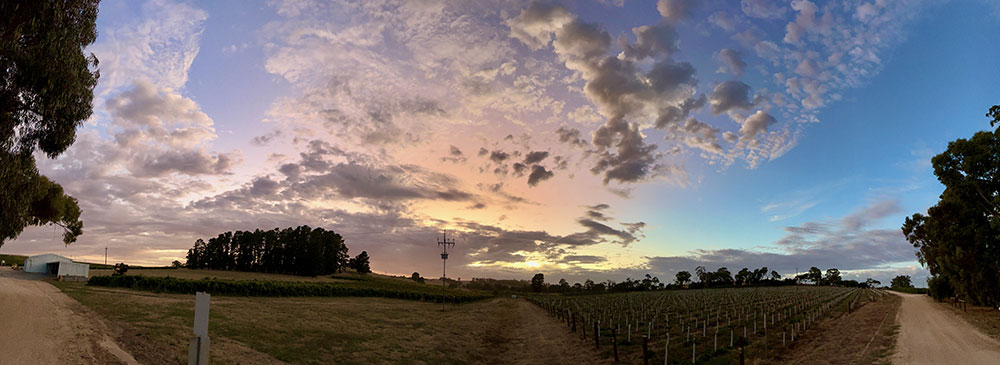
It’s pre-dawn and pitch-black as I make my way around the property, led only by the light of my phone. I step off the lush green grass and now the only sound is my footsteps crunching on the gravel. I’m in search of a memorable shot of a vivid dawn over the vines. But there are no elaborate colours in the sky today, so I put my camera aside and opt instead for a panoramic 180-degree shot with my phone.
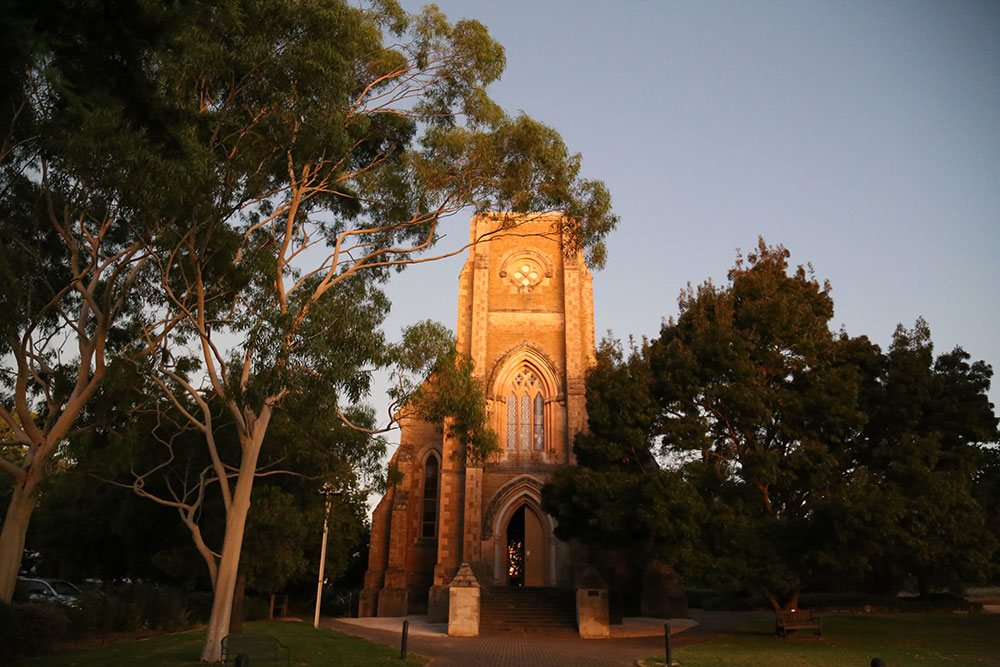
Several hours later, at the end of the day, the cicada chorus is in full swing and the setting sun brings a warm orange glow to the huge bell tower of St Aloysius’ Church. Built in the Gothic Revival style, this church has served the Parish of Sevenhill since its completion in 1875. Interestingly, the glass panels on the entrance doors have suddenly taken on a life of their own as the reflected sun makes it look as though the plain glass is now a stained-glass window.
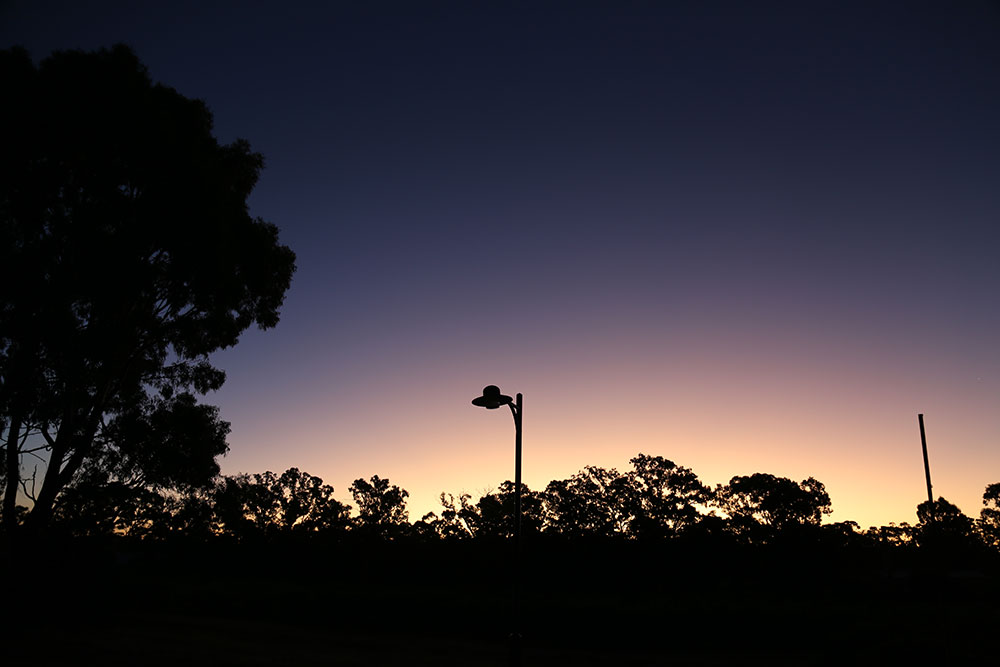
Behind me, the sky is turning to a hue that an artist would be proud of – a mixture of cobalt and gentian. The sun has long gone, leaving just a strip of fading gold directly above the trees, anchoring the dramatically darker sky above.
Turned to stone:
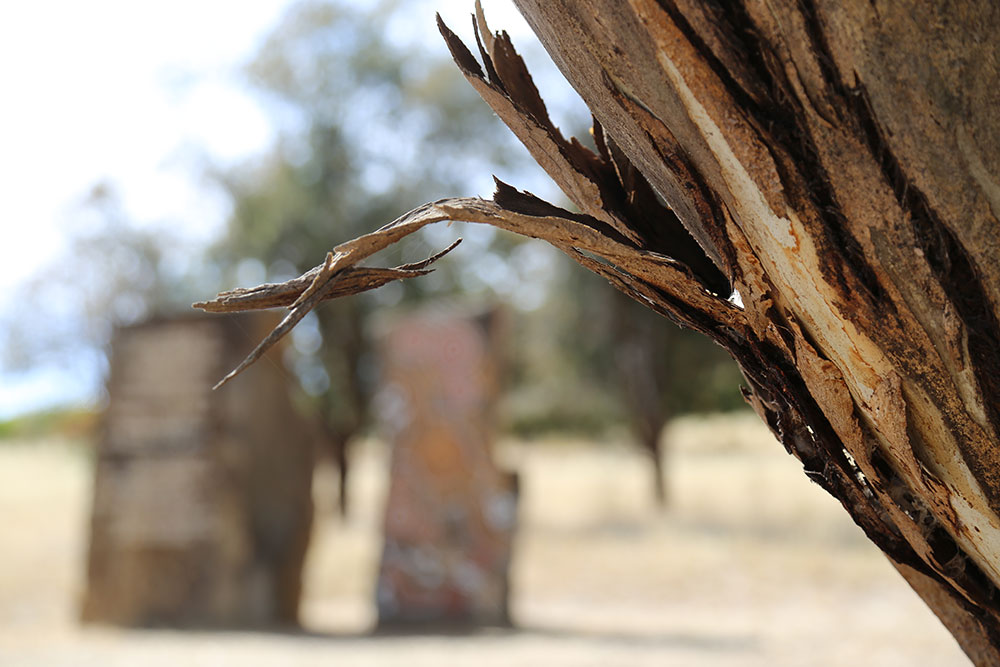
When you arrive at the main entrance to the property, look to your right and you’ll see beautiful native trees on a landscape that can look so dramatically dry and stark that you have to remind yourself how fertile this soil actually is. Beyond the strips of bark that have broken away from the tree trunks, you see two distinct shapes that are almost obelisk-like.

Go closer and you’ll notice that they are two huge slate rocks – one weighing six and a half tonnes and the other eight tonnes. Husband and wife Ngadjuri artists Adam and Elley Warrior recently painted one of the rocks to commemorate the deep bond between the first Jesuits and their own ancestors.
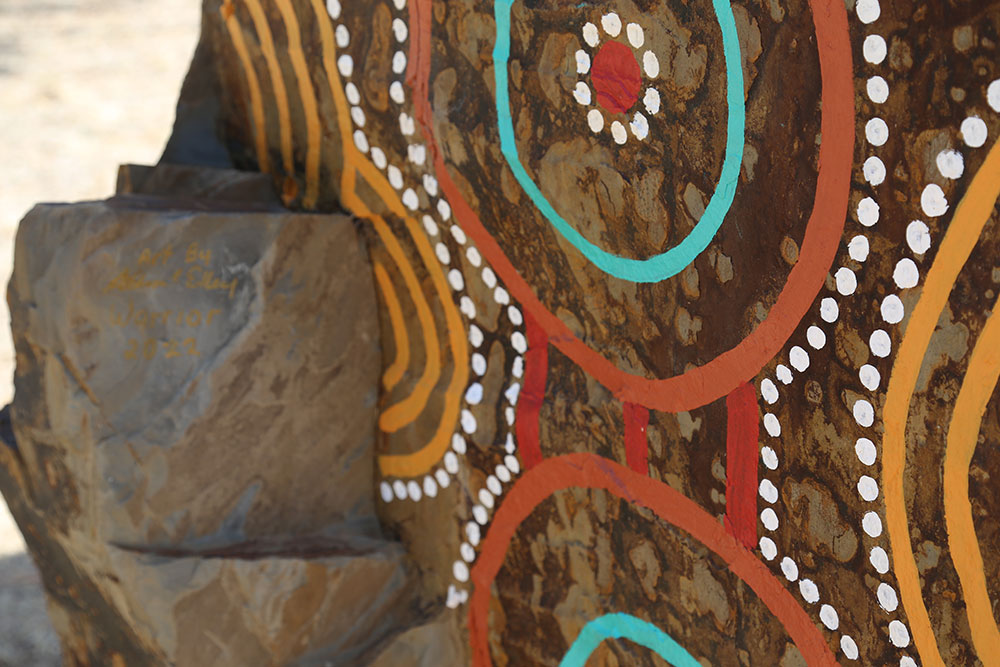
It was Fr Brendan Kelly SJ, Superior of Sevenhill, who approached Adam and Elley and explained the story of how the Jesuits first came to meet the Ngadjuri people and the strong connection that both sides subsequently formed. “That is exactly what our painting depicts,” they told me earlier this year.
St Aloysius’ Church:
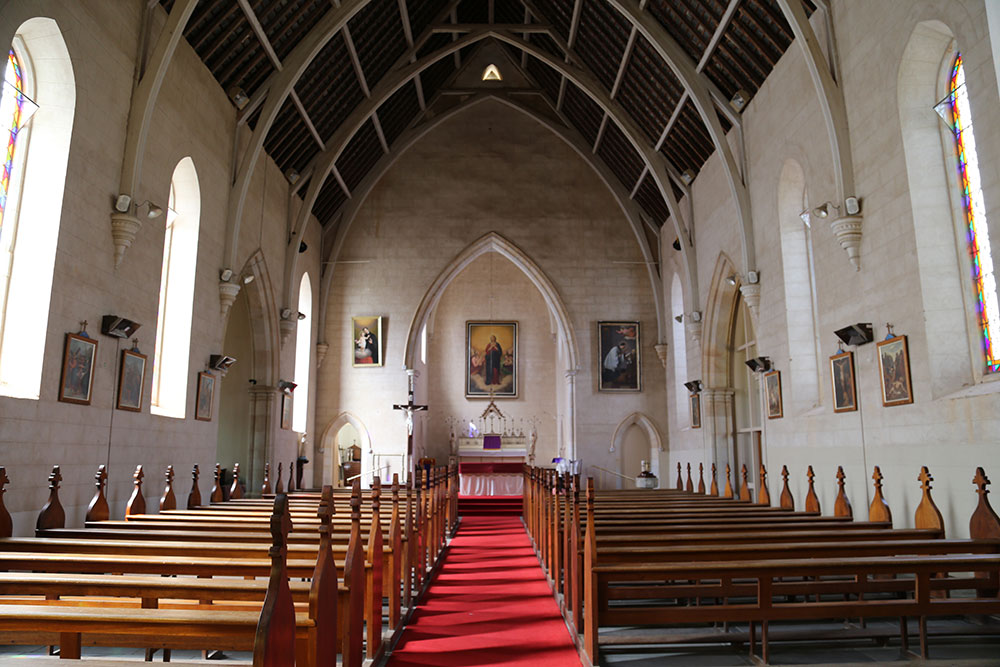
The graceful ceiling arches were lifted into place by teams of almost two dozen men, presumably using basic pulley systems. Built from local stone, the church features a slate roof, Mintaro slate floors and stained-glass windows.
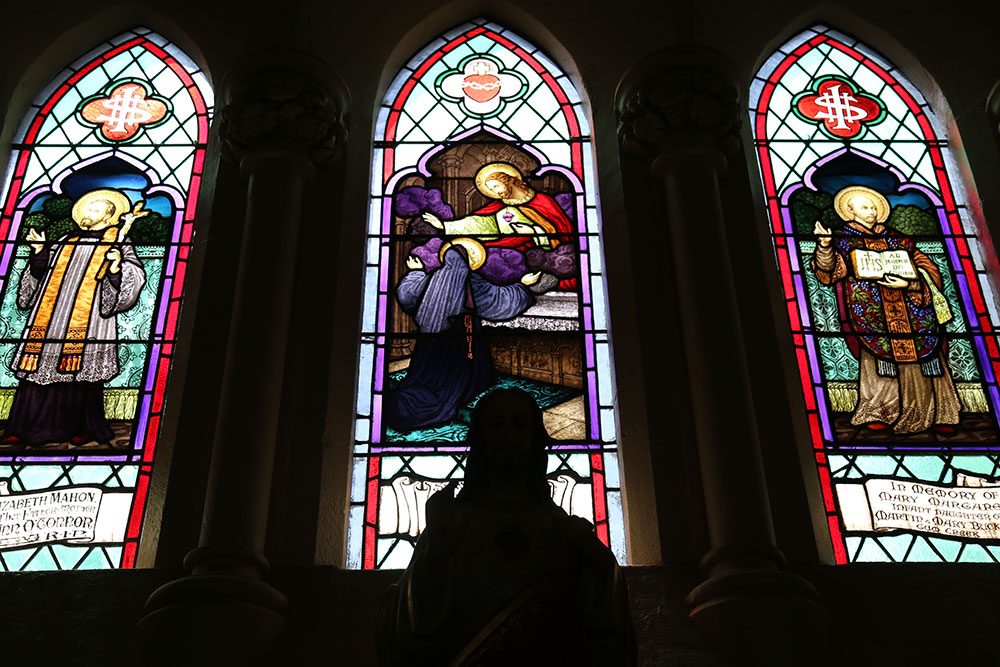
The stained-glass panels cast strong linear rainbows on the floor, while the waning sun creates capricious pastel-coloured patterns on the walls, amorphous abstracts that change in intensity and shift almost imperceptibly as the sun moves.
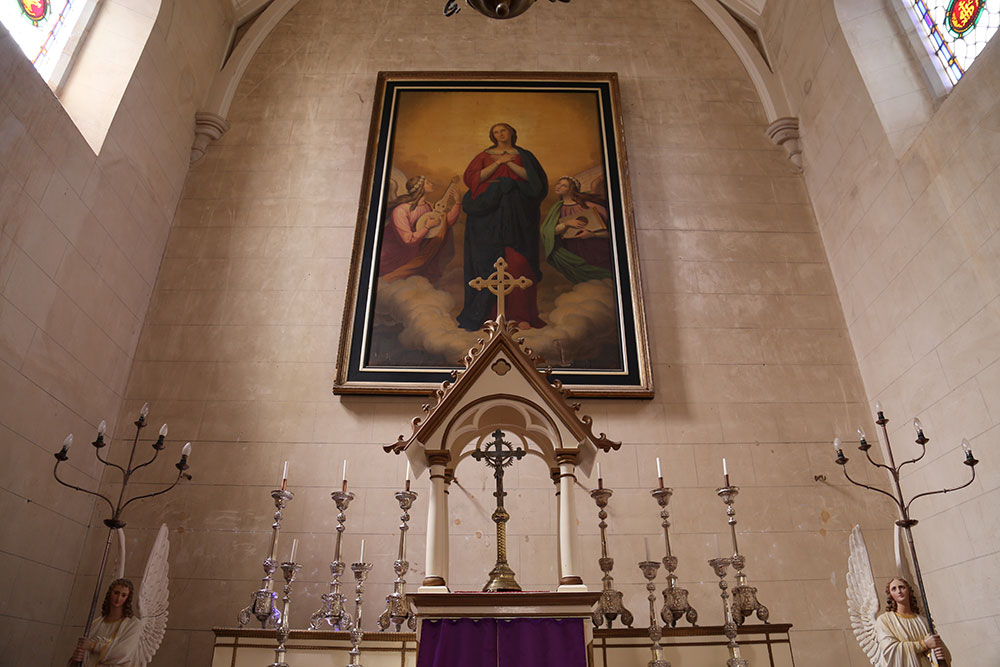
Above the altar, instead of the traditional stained-glass window, there is a striking oil painting of the Madonna that was originally presented to the Jesuits in Europe by King Ludwig II of Bavaria in 1848.
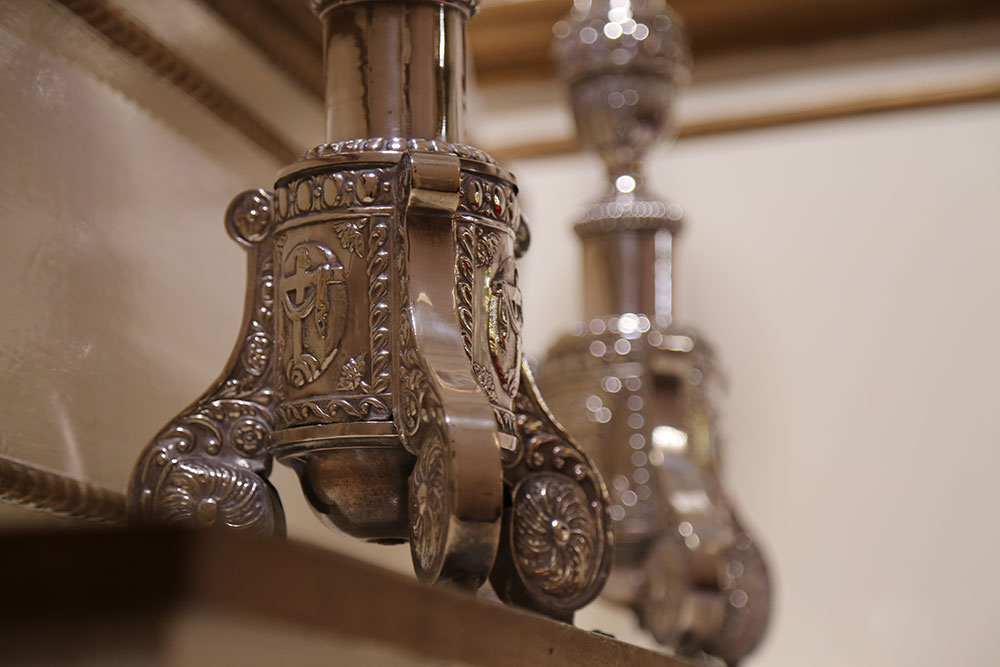
The church has its own collection of metal artefacts that are still in everyday use on the altar and beyond, their graceful design bearing witness to an almost-forgotten era of craftsmanship, when intricacies of script and art were created by hand.
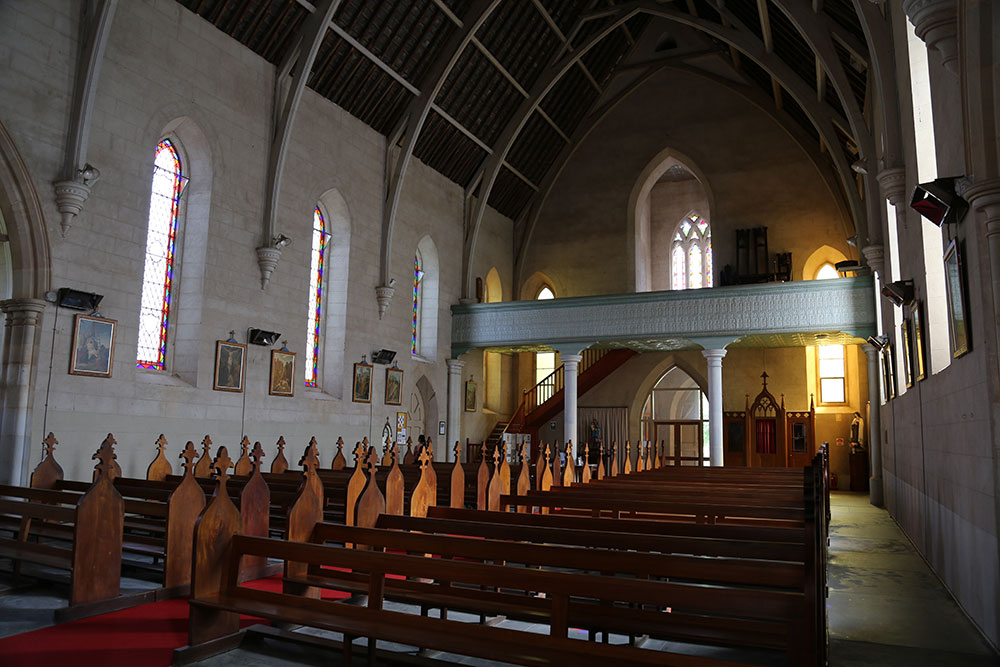
The wooden pews date back to the original church, their simple timber grace creating a uniformity that brings an extra element of glow to the sun at any time of year. Beyond the main doors is a glass display cabinet that houses original vestments worn by the first Jesuits in the area.
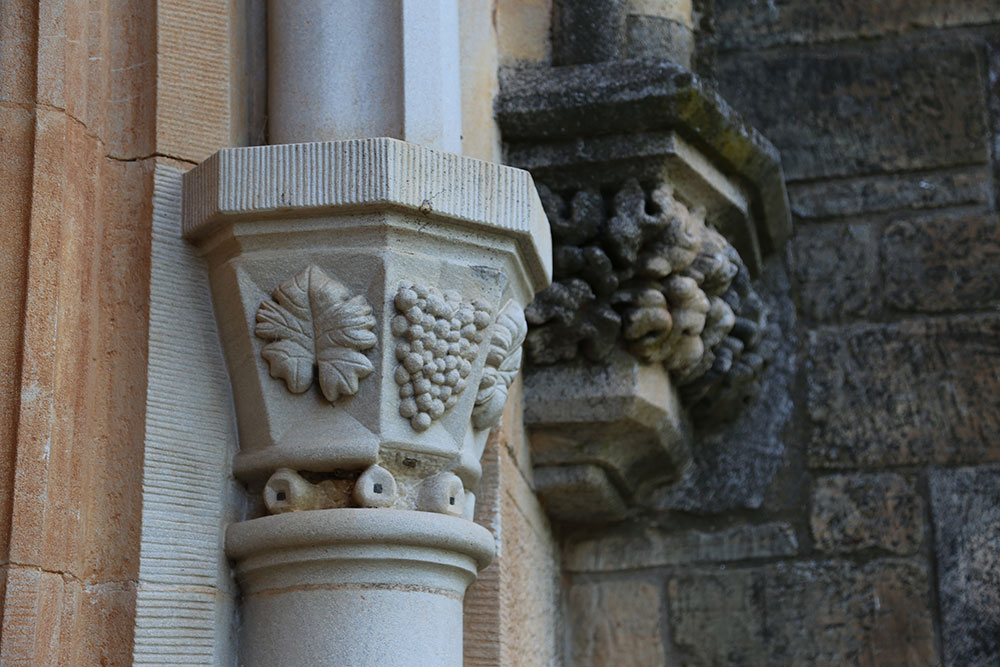
The pillars at the entrance to the church represent Sevenhill’s valued heritage as a winery, with the columns depicting vineyard leaves as well as bunches of grapes.
Viticulture heritage:
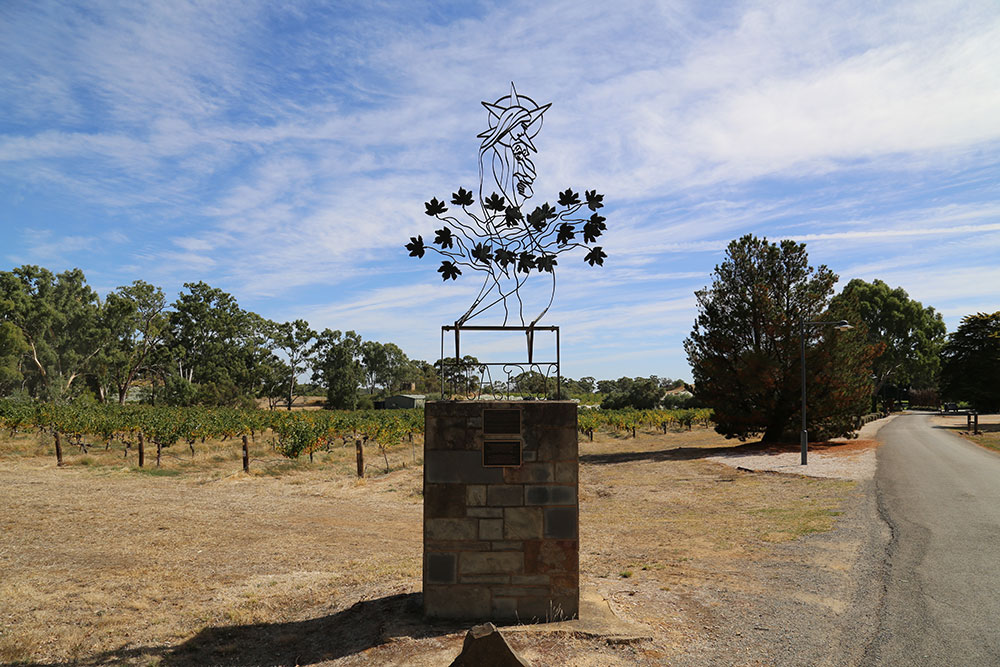
This metal artwork is titled ‘Madonna of the Vines’ and has looked over one section of the vineyard for almost two decades. The word ‘Mary’, in flowing metal script, is at its base, and the striking bronze sculpture rests on a sturdy stone plinth. It was commissioned by Desmond and Mary Kennedy to honour the late Br John May SJ, the long-serving winemaker at Sevenhill Cellars. The 1994 sculpture, by Andrew Parish of Woodville, South Australia, depicts the Madonna “walking through the vines and blessing them to ensure good wines to follow”. It is 2.31 metres high and weighs 100 kilograms.
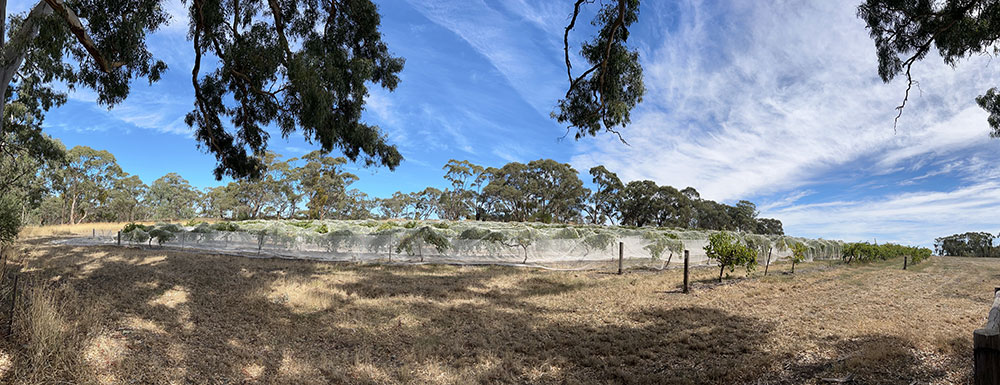
It is almost impossible for a photographer without access to a drone to capture the scale of the vineyard which spans both sides of the church. But here I resort once more to my phone to capture a panoramic shot of the sun-drenched vines bordered by a phalanx of leafy trees on all four sides, covering every point of the compass.
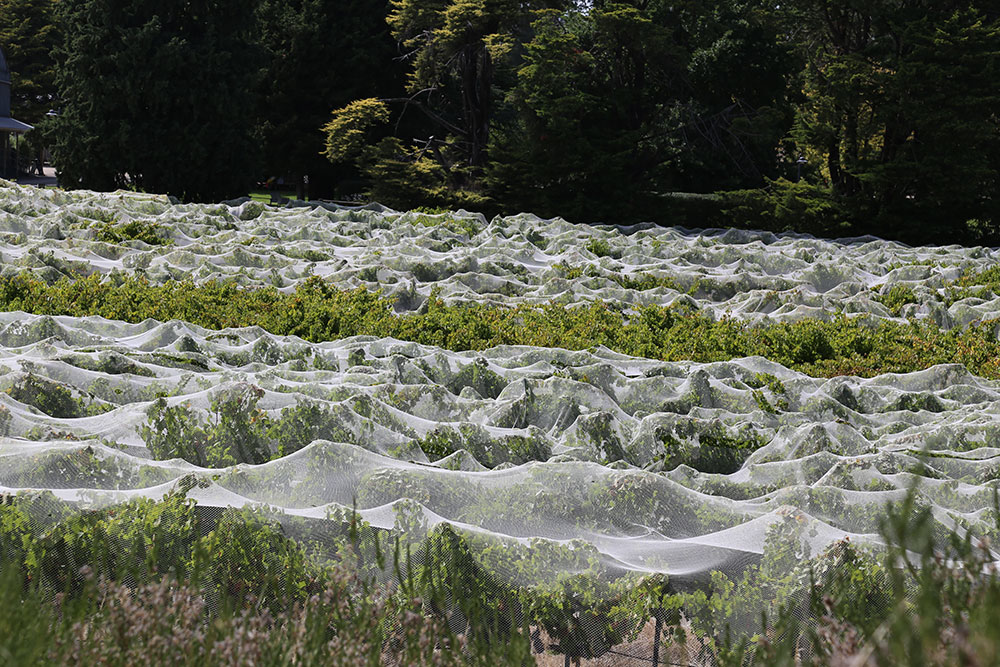
Netting stretched carefully across the vines not only protects them, but creates a unique landscape. In the right light, and photographed from a judicious angle, the whole scene takes on the look of gentle swells on a serene green lake. The soft green of the leaves in this shot is deliberately contrasted with the dark tress on the perimeter.
The shrines:
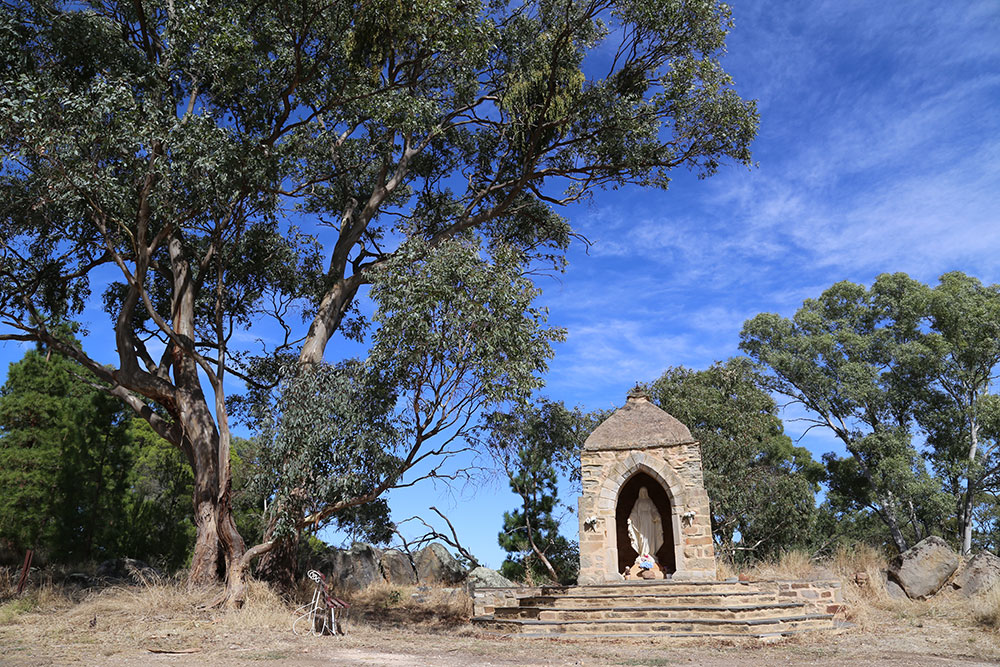
The Madonna Shrine is situated on the western end of the vineyard. It blends harmoniously into the colours of the landscape, its stone walls echoing the sandy colour of the native grasses that surround the area. It is accessible by five generously broad yet shallow steps, and for those who wish to spend more time in contemplation, there is a wooden bench with a white-painted metal frame to the left, and another sturdy wooden bench nearby.
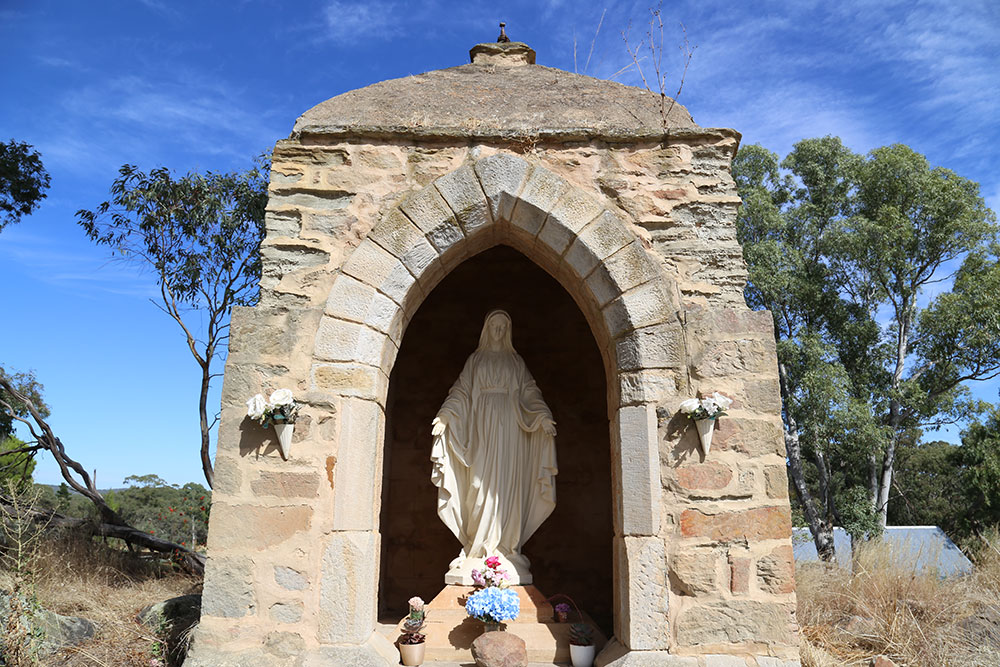
The 19th-century stonemasons who created this shrine knew exactly what they were doing. Its grotto-like structure creates shade for the Madonna on even the hottest summer days. There is just enough space on either side of the Madonna for a parched or weary pilgrim to find some welcome shade beside the statue.
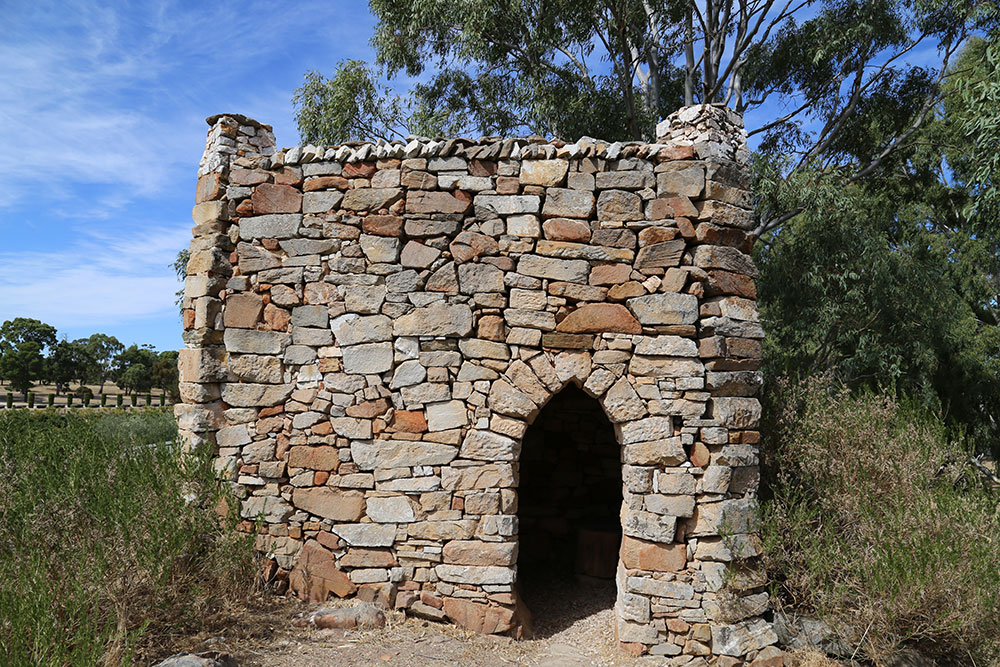
The Loyola shrine is a unique construction, with no mortar used in its design. Even the geometrically-precise arched entrance comprises only local stones held together by a judicious load-bearing design. This and the nearby Marian shrine are just two of the many aspects that serve the Sevenhill Centre of Ignatian Spirituality.
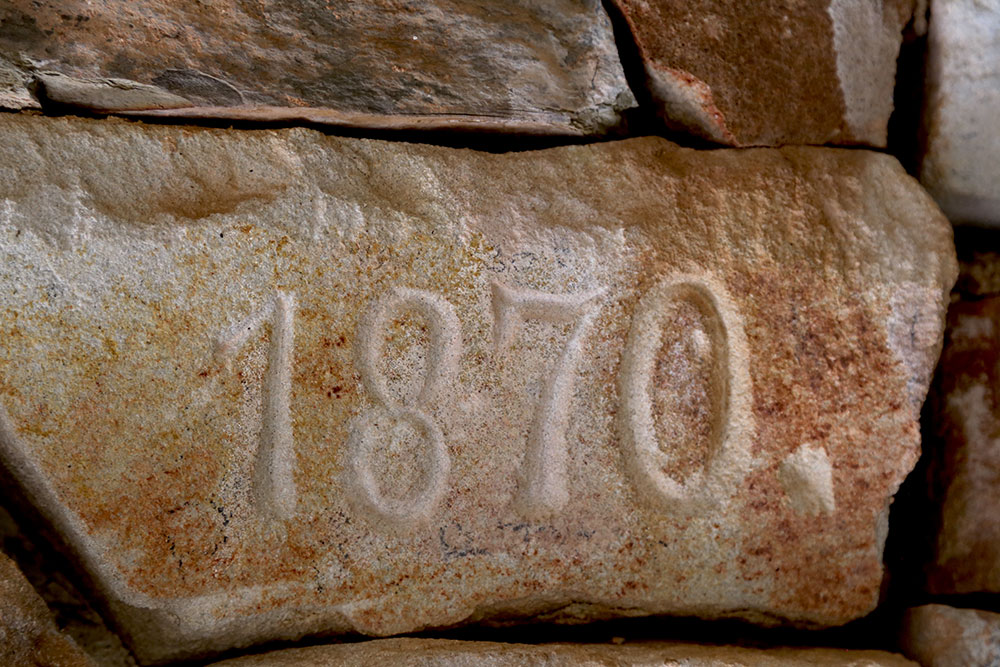
Inside the Loyola Shrine’s cool, shady interior is one particular stone that carries the date of construction – 1870. At first glance, it looks like a gracefully etched or carved date, but look closer and you’ll notice that the numerals are actually raised above the stone’s surface. Created by hand, they are as finely produced and symmetrical as any mechanical font.
Weikert cottage:
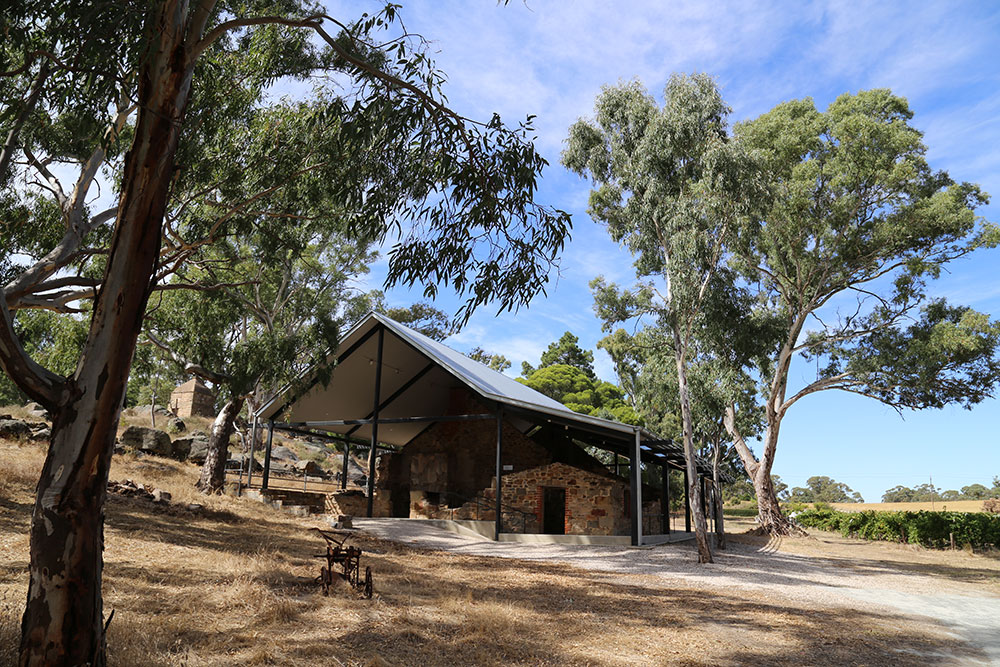
Franz Weikert was a fairly prominent farmer from 19th-century Silesia, a Baltic province of what was then known as Prussia. Seeking religious freedom, he, his wife and their eight children led a group of 146 Catholics to Australia, the Weikerts having paid the cost of the voyage for the entire travelling party. Among them were thirteen farmers, two labourers, seven carpenters, three cobblers, one stonemason, three tailors, a shepherd, two servants, six weavers, two coach builders, two blacksmiths and a clockmaker.
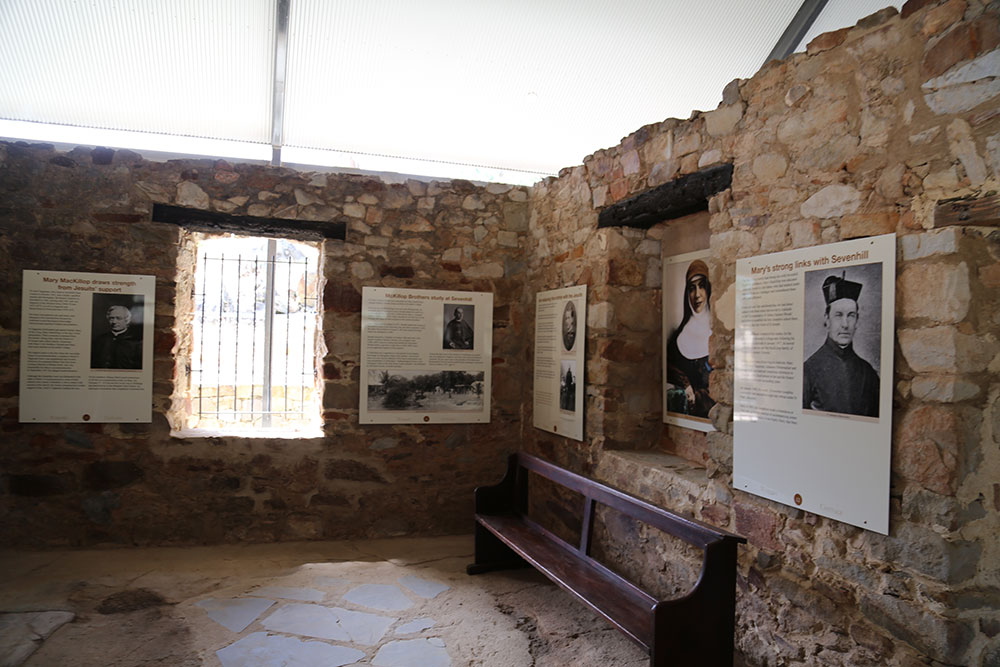
While the Weikerts wanted one priest, they actually got two – newly ordained Austrian Jesuit priests, Fr Aloysius Kranewitter and Fr Maximilian Klinkowstroem, although the latter became ill and had to return to Europe. Weikert bought 100 acres of prime land and named the property Sevenhill, referencing the seven hills of Rome. In their twilight years, an ailing Weikert and his wife Fransiska lived in this stone cottage, under the care of the Jesuits, until they passed away in 1875 and 1888 respectively. Storyboards now tell tourists and pilgrims the story behind the cottage and the Sevenhill property.
The cellars:
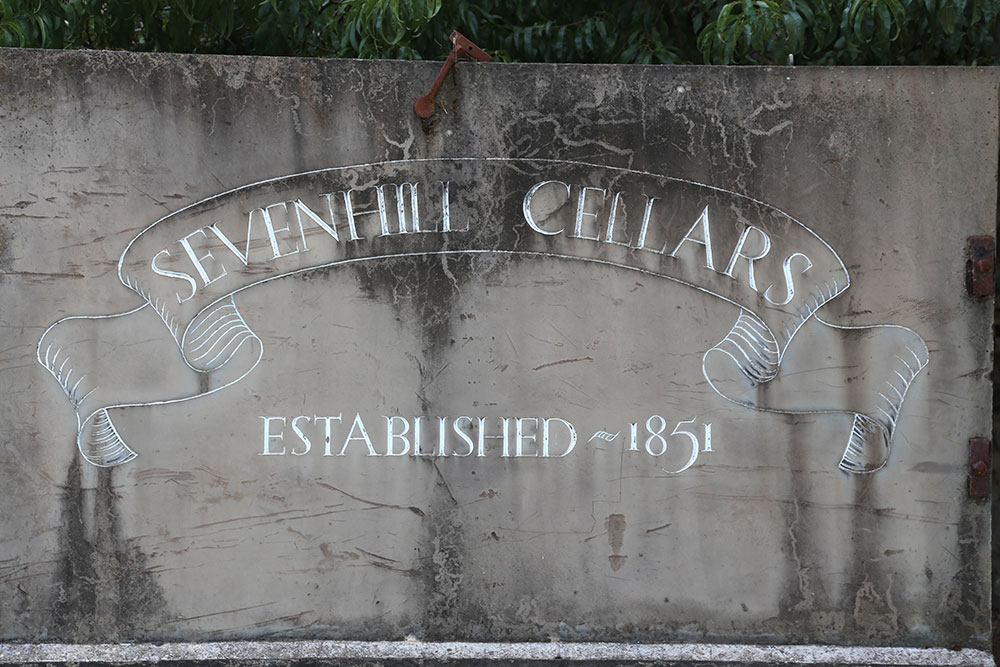
As the story goes, Br Joannes Schreiner took a wheelbarrow with him as he traversed the neighbouring hills, taking vine cuttings back to Sevenhill to propagate them en masse. The initial vine cuttings were taken from the Hawker family at Bungaree Station, north-west of Clare.
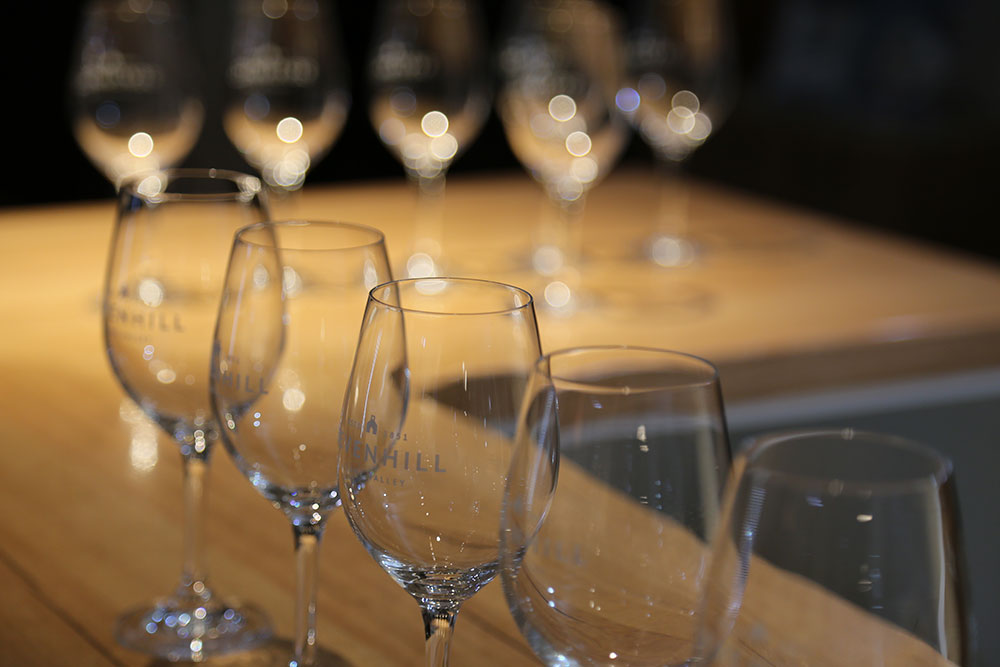
The first vines were planted here in 1851 to produce Sacramental wine, enabling faith communities to celebrate the Eucharist. In the decades since then, Sevenhill Cellars has added a range of award-winning table wines to their portfolio.
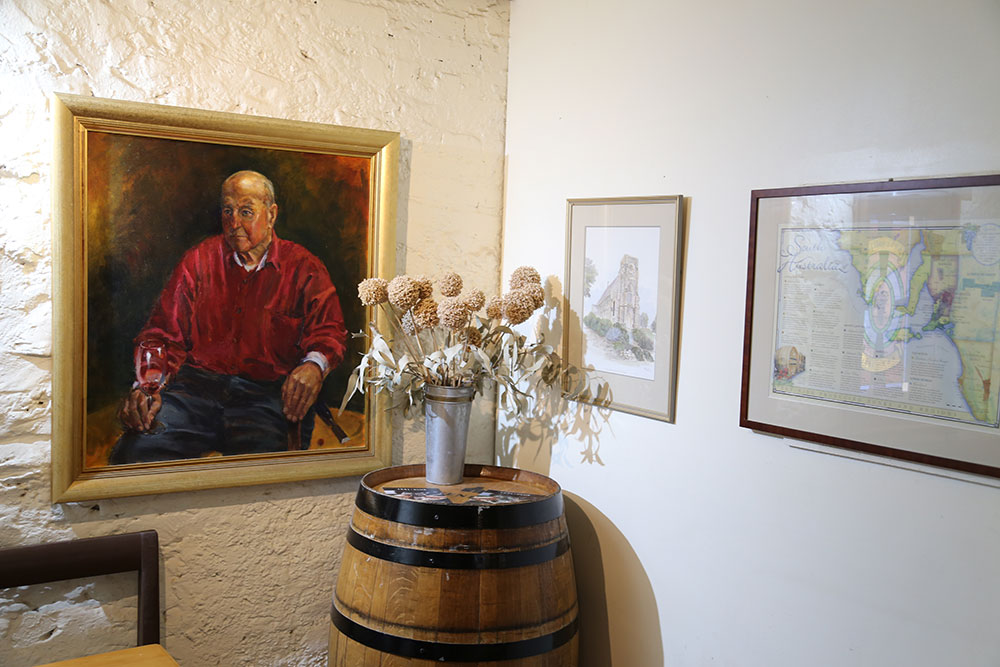
This painting commemorates the legacy of the late Br John May SJ, the long-serving winemaker at Sevenhill Cellars. He was the seventh Jesuit winemaker here from 1972 until his retirement from full-time work in 2003. He died in August 2021, aged 92, and is buried in the crypt below St Aloysius’ Church.
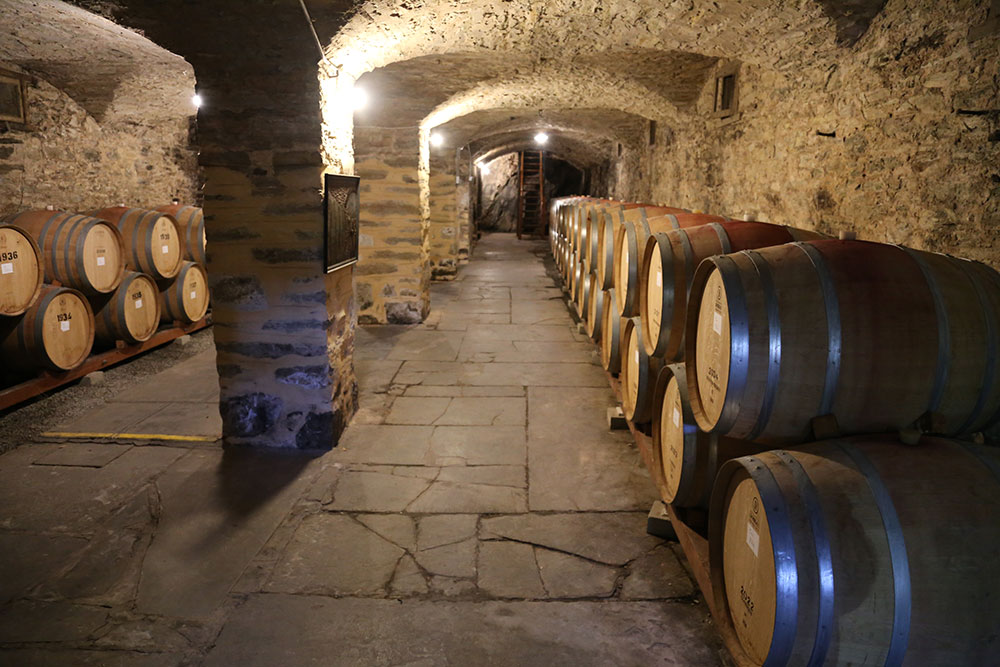
Tours of the Sevenhill Cellars are a major attraction. Sacramental wine expanded beyond Australia’s borders to countries throughout South-East Asia. The Cellar Door attracts more than 40,000 visitors each year.
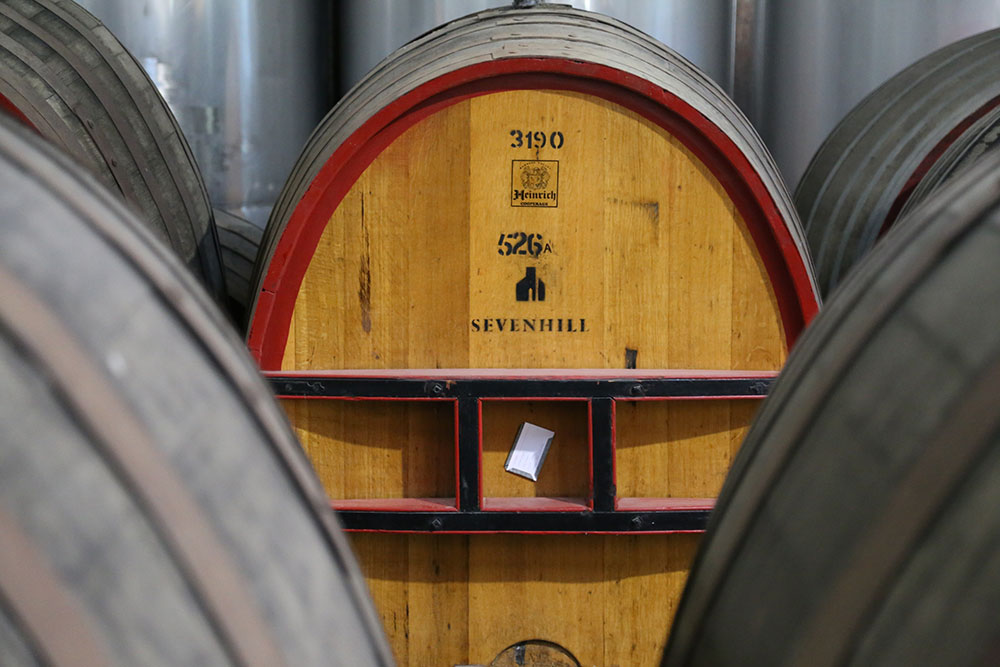
The iconic architecture of St Aloysius’ Church can be seen on the barrels in the cellars, forever celebrating the historic link between the Jesuits and the winery.
